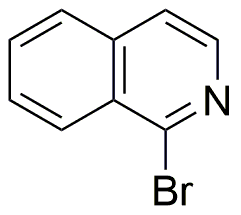1-Bromoisoquinoline is widely utilized in research focused on:
- Synthesis of Pharmaceuticals: This compound serves as a key intermediate in the synthesis of various pharmaceutical agents, particularly in developing drugs targeting neurological disorders.
- Organic Synthesis: It is commonly used in organic chemistry for the construction of complex molecular architectures, allowing researchers to create new compounds with desired properties.
- Fluorescent Probes: 1-Bromoisoquinoline can be modified to develop fluorescent probes, which are essential in biological imaging and tracking cellular processes in real-time.
- Material Science: The compound is explored in the development of novel materials, including polymers and nanomaterials, enhancing properties such as conductivity and stability.
- Research in Chemical Biology: It plays a role in studying enzyme interactions and biological pathways, providing insights that can lead to new therapeutic strategies.
General Information
Properties
Safety and Regulations
Applications
1-Bromoisoquinoline is widely utilized in research focused on:
- Synthesis of Pharmaceuticals: This compound serves as a key intermediate in the synthesis of various pharmaceutical agents, particularly in developing drugs targeting neurological disorders.
- Organic Synthesis: It is commonly used in organic chemistry for the construction of complex molecular architectures, allowing researchers to create new compounds with desired properties.
- Fluorescent Probes: 1-Bromoisoquinoline can be modified to develop fluorescent probes, which are essential in biological imaging and tracking cellular processes in real-time.
- Material Science: The compound is explored in the development of novel materials, including polymers and nanomaterials, enhancing properties such as conductivity and stability.
- Research in Chemical Biology: It plays a role in studying enzyme interactions and biological pathways, providing insights that can lead to new therapeutic strategies.
Documents
Safety Data Sheets (SDS)
The SDS provides comprehensive safety information on handling, storage, and disposal of the product.
Product Specification (PS)
The PS provides a comprehensive breakdown of the product’s properties, including chemical composition, physical state, purity, and storage requirements. It also details acceptable quality ranges and the product's intended applications.
Certificates of Analysis (COA)
Search for Certificates of Analysis (COA) by entering the products Lot Number. Lot and Batch Numbers can be found on a product’s label following the words ‘Lot’ or ‘Batch’.
*Catalog Number
*Lot Number
Certificates Of Origin (COO)
This COO confirms the country where the product was manufactured, and also details the materials and components used in it and whether it is derived from natural, synthetic, or other specific sources. This certificate may be required for customs, trade, and regulatory compliance.
*Catalog Number
*Lot Number
Safety Data Sheets (SDS)
The SDS provides comprehensive safety information on handling, storage, and disposal of the product.
DownloadProduct Specification (PS)
The PS provides a comprehensive breakdown of the product’s properties, including chemical composition, physical state, purity, and storage requirements. It also details acceptable quality ranges and the product's intended applications.
DownloadCertificates of Analysis (COA)
Search for Certificates of Analysis (COA) by entering the products Lot Number. Lot and Batch Numbers can be found on a product’s label following the words ‘Lot’ or ‘Batch’.
*Catalog Number
*Lot Number
Certificates Of Origin (COO)
This COO confirms the country where the product was manufactured, and also details the materials and components used in it and whether it is derived from natural, synthetic, or other specific sources. This certificate may be required for customs, trade, and regulatory compliance.


